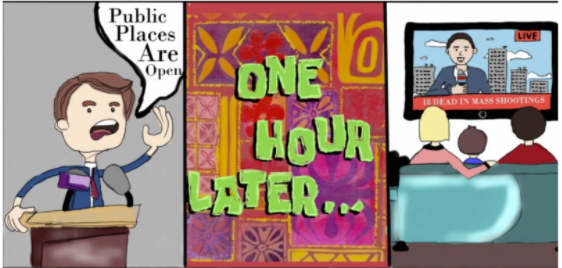
Cartooning is one of the most fun ways to express yourself. There is so much creativity involved from the type of cartoon to the media that you use to the color palette. With cartoons there is so much room to express yourself through this unique art form.
The first step is to pick your idea and start, which can be the hardest part. Inspiration can come from almost anything.
Now it is time to pick the coloring medium. Colored pencils, water-based markers, alcohol-based markers, watercolors, acrylics, digital and pastels are some of the most commonly used mediums.
There are many different mediums to put your cartoons on. Sketchbooks handle colored pencil better than inks. Mixed media paper is great for anything. Bristol board is good for markers. Watercolor paper and canvases are classic options for watercolor and acrylics.
I would like to explain my current toolkit. I always use a pack of black pens with multiple tip sizes for inking. Zig, Micron, and even Five Below pens are all great choices.
The next items are my coloring tools. My tools are on the higher end, because they give me a much better finished product, with their blendability, color payout and color selection. For colored pencils, I use Prismacolors and a skin-tone pack of Derwents. These pencils allow for mixing new colors due to their soft lead and therefore blendability.
I use two types of markers: 1.) water-based markers from Tombow in portrait, pastels, and brights, and 2.) alcohol-based markers from Master’s touch in a mutli-pack, skin tones, blues, and pinks and purples along with some blenders. Hobby Lobby is where I purchase most of my materials.
After the general idea is decided, start sketching. The use of shapes and lines can help this process. When drawing a person always start with the head, and move down through the body. Consider principles of art such as negative space to make the art unique. Once the cartoon is done, settle on what should be inked by erasing some of the lines.
Inking helps preserve the art from pencil smudging, and it gives the cartoon perfect clean lines to color in. It also adds a lot of dimension to the cartoon.
To ink a drawing, trace the lines using black pens. Use different sizes because not every line should be the same size. Hair and clothing should be done with a big pen, skin is usually a medium pen, and tiny details like the face and jewelry are inked with a small pen.
After inking, erase over everything to remove the excess pencil.
The final step is coloring. Coloring is not always necessary, but I strongly recommend it because color theory is an important element of art. The colors used in a cartoon can help convey meaning behind your cartoon. Colors help give the cartoon more dimension.
With gradients, be gentle and do not overdo them. The process may take a while but continue working until you have your desired look. You can build with colored pencils and use blenders for marker works. Colors can also be created by a layering process.
For white details, go in with white colored pencil, but I also suggest using white gel pen or paint pen for defined white lines and shapes. When making a comic, do not forget to add the words in a thick pen. Don’t worry about penciling the words first; simply write neatly and use the space accordingly.
Cartooning is one of my favorite ways to express myself and I hope that it will become one of yours, too. I especially love learning how to use new media and techniques, and see my improvement over time. With this uncommon art form you can create your own world and learn something new through drawing cartoons.

